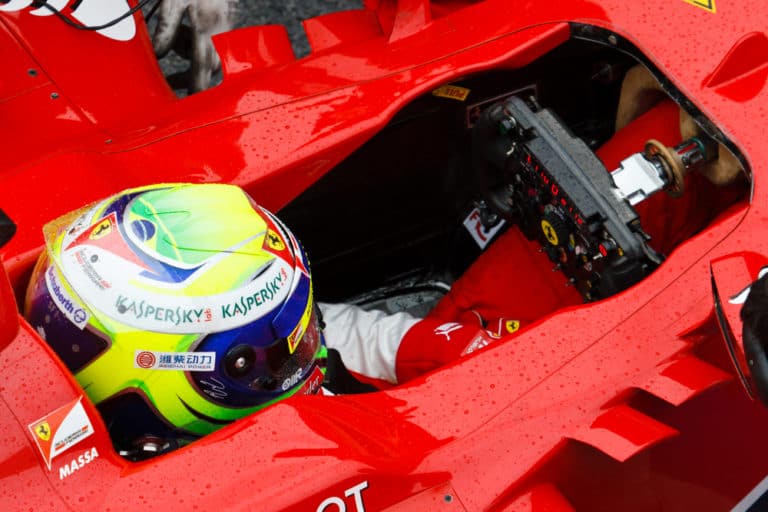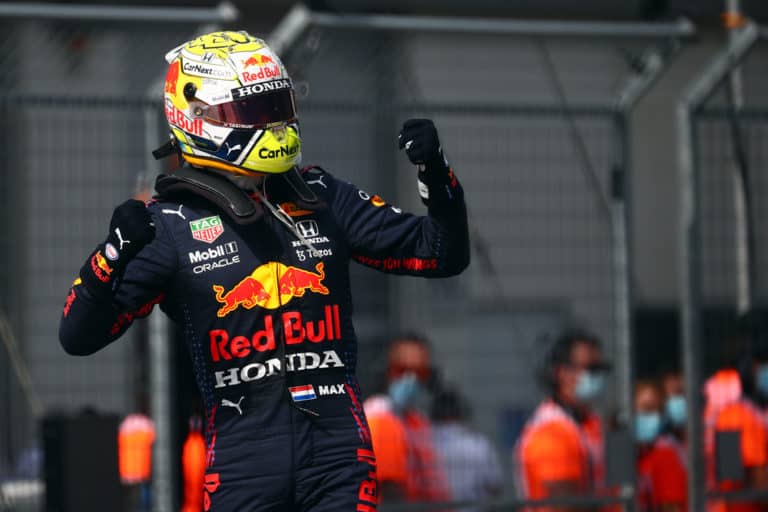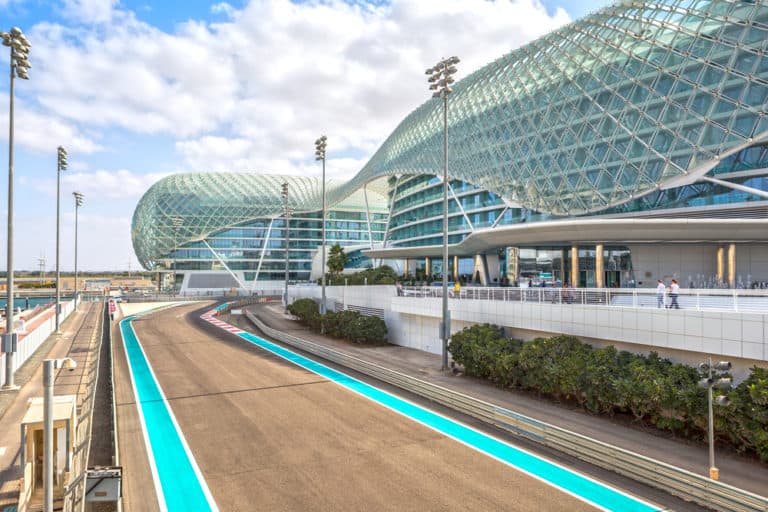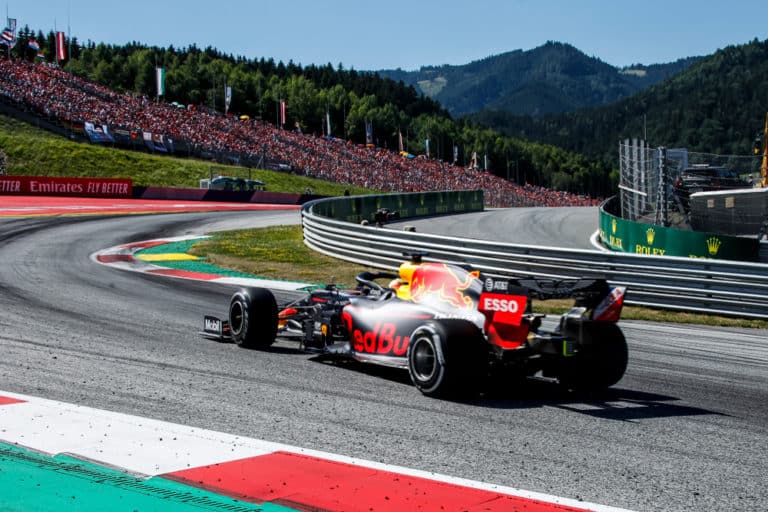Image editorial credit: Ev. Safronov / Shutterstock.com
Formula 1 is an incredible sport. It is the peak of motorsport technology, and it pushes the motor industry further forward every year. Most F1 fans put a lot of emphasis n the cars in F1, but what about the drivers? How does the driver determine race performance? Does fitness have that much to do with it? How fit are Formula 1 drivers actually?
Formula 1 drivers are remarkably fit. They require a specialized level of fitness for racing F1 cars. Fitness is vital for maintaining focus and racing ability due to the immense strain that’s experienced while racing. Muscle strength is vital to withstand racing g-forces and fight fatigue.
F1 drivers experience far more strain during a race than most other athletes experience while competing in their sport. Formula 1 races are intensely taxing on the driver, and this requires the drivers to be physically and mentally prepared for everything the race has to give them. Let’s explore how fit Formula 1 drivers actually are.
Do Formula 1 Drivers Have To Be Fit?
Much of the focus of Formula 1 races is on the F1 racing car. These machines are precision-built for immense speed, incredible handling, and they are the highest performing vehicles in worldwide motorsport.
While the machines that are used for racing in F1 are truly in a league of their own, there is much to be said about the drivers that tame these outrageous cars on the race track.
Formula 1 drivers are racing machines in their own right, and they have to be specially trained to handle the intensity of Formula 1 races. Formula 1 drivers have to be remarkably fit, and they have to maintain this high level of fitness throughout their racing career.
Without a high and specialized level of physical and mental fitness, F1 drivers would not be able to compete for long in the sport. The physical tole of F1 racing is far greater than many realize, and the drivers are required to be among the fittest athletes in any sport worldwide.
In fact, the immense intensity of Formula 1 races require the drivers to be so fit that they can withstand more than 5-G (5x the force of gravity), losing up 5kg (11lb) is water, apply 80kg (176lb) of force to the pedals, and maintain core and muscle strength when racing, all while maintaining focus, feeling the car, communicating with their team, operating a complicated vehicle, and trying to win a race against the world’s best racing drivers.
This is a lot to ask of any person, but the drivers in Formula 1 gladly take on this burden for the sake of racing glory.
Why Do F1 Driver Have To Be So Fit?
Formula 1 drivers are among the most fit athletes of any sport in the world. Not only are they required to have maintained a high level of fitness for racing, but the fitness that they require is specially designed for maximum effectiveness in Formula 1 racing.
Not many realize how important it is for F1 drivers to be fit and why they are required to develop such a specific fitness for F1 racing.
Let’s take some time to go over some of the reasons why F1 races have to so fit:
G-Forces
Let’s begin with the aspects of an F1 race that require high levels of fitness.
One of the most prevalent reasons for an F1 driver’s fitness level is the intense G-forces that are experienced during a race.
G-force is the gravitational force equivalent experienced when accelerating or moving at high speeds that causes an intense perception of weight.
To put it plainly, g-force refers to the gravitational force exerted on the body during intense acceleration. For example, 1G is the same as the normal gravitational pull felt on earth, while 5G is 5x the gravitational force, making everything feel 5x as heavy and putting 5x the load on the body.
During a race, the drivers on Formula 1 experience up to 6G while cornering at high speeds, braking causes an exertion of 5G on the driver, and acceleration may exert more than 2G of force on average.
This means that F1 drivers must be able to withstand up to 6 x the gravitational force of the earth at certain points while racing. Normal people lose consciousness at around 5G, so racing an F1 car at high speed while pulling 6G is very intense.
This high level of experienced g-force required the drivers in F1 to be extremely physically fit. They must be able to hold their heads up, turn their arms, hold onto a steering wheel, keep their bodies upright in the cockpit, operate the pedals, and remain conscious while experiencing 6 x the force of gravity.
The effects of the high g-forces are especially felt by the head of the driver. The drivers’ head alone weighs up to 25kg (55lb) more than normal while cornering, and their helmet weighs 7kg (15lb) more than it usually does.
This means that F1 drivers must have an exceptionally strong neck and chest muscles to withstand this level of force.
Every muscle in the F1 drivers’ body must be strong and fit to withstand these immense forces and also to protect the body from damage. Bones such as the ribs are easily broken by string g-forges, and internal organs can take damage from it as well.
Having strong, fit muscles protects the body from these forces and allows it to function while racing.

Elevated Heartrate
The heart rate of an average healthy person should be around 60bpm when resting, but while racing, the heart rate of an F1 driver is sustained at around 160 – 180 beats per minute and peaks at more than 200 beats per minute.
This is very taxing on the cardiovascular system, and the F1 driver must be fit enough to handle this kind of strain.
F1 drivers are so fit that their average resting heart rate is around 40bpm, indicating extremely good physical fitness.
Every Formula 1 driver maintains a strict cardiovascular workout routine to maintain the cardiovascular health that is crucial for racing in F1.
Core Strength
Core strength is another of the most vital aspects of the physical fitness of Formula 1 drivers.
The strength of the divers’ core determines their ability to stay upright in the cockpit, how well protected their internal organs are, and how well they handle the g-forces of racing and of crashing.
A driver’s core strength allows them to maintain a high level of performance while racing and fights off fatigue. The easier it is to maintain your balance and keep your strength up while racing, the more likely you are to perform well.
This is why core strength and overall fitness are vital for F1 drivers.
Muscle Strength
Must strength is a vital aspect of an F1 driver’s fitness. Most physical training of F1 drivers is targeted at core strength, cardio, and neck strength, but the overall muscle strength of the F1 driver is vital as well, especially in the arms and legs.
The strength that F1 drivers require in their arms is such that they must be able to hold onto and operate the steering wheel of an F1 car while battling intense g-forces and external pressures while maintaining strength and responsiveness during a two-hour-long race.
This requires great strength from the muscles in the arms, as well as good endurance and control.
Leg muscles are important too. For example, the downward pressure that an F1 driver must exert on the brake pedal leading up to a corner after a fast straight can be as much as 80kg (176lb) of force.
This is the highest level of force that must be used to depress the brake pedal, but the leg muscles of an F1 driver must be so fine-tuned that they are able to exert that full 80kg (176lb) force, but they must also be able to only exert 20%, or 50% of that same force without missing a beat.
Having the ability to press extremely hard, extremely light, and any point in between on-demand and accurately requires incredible muscular control that only comes from a high level of fitness in the muscles.
These are just two examples, however, and the same is true for every muscle in the body of an F1 driver. The muscles must be finely tuned and incredibly fit, both to protect the body and to be able to function at a very high level while racing.
The racing suit and protective gear that is worn by F1 drivers also require them to have good muscle strength, as this compounds the effects of the increased g-forces experienced while racing.
Heat And Perspiration
Another factor of F1 racing that requires amazing physical fitness is the heat that F1 driver experiences while racing.
The temperature inside the cockpit of an F1 racing car averages more than 50oC (122oF). This heat is sustained for two hours during a race and is increased on the particularly hot and humid tracks in some parts of the world.
Also, taking into account the added heat of the protective gear and racing suit that the drivers wear while racing, F1 drivers must be able to withstand extreme heat while racing.
The high heat that the drivers’ experience means that drivers lose between 3 – 5 kilograms (6.6 – 11lb) of body weight due to perspiration alone while racing.
This means that dehydration is a real problem to these drivers, and their bodies must be at a level of physical fitness to continue to function at an extremely high level while dehydrated, overheating, and losing weight rapidly.
This is a level of fitness that very few athletes need to achieve, but it is a minimum requirement for Formula 1 racing drivers.
Flexibility And Mobility
Flexibility and mobility are two very important aspects of physical fitness for Formula 1 drivers.
These drivers are subjected to extreme heat, severe intensity, high g-forces, and massive physical and mental strain, all the while being confined to a very tight cockpit that restricts movement and requires the driver to be flexible enough to perform complicated driving maneuvers inside of it.
This requires a lot of flexibility and high mobility ability, as the driver must be able to perform everything necessary for winning an F1 race while being heavily restricted by the cockpit and keeping their own body in alignment with the task at hand.

Weight Maintenance
Formula 1 is a sport that is built and won by the fine details. Every car and every driver on the F1 grid are among the best in the world, and they perform at the same high level of performance while dealing with the same intense race conditions.
The cars that are used in Formula 1 are designed for winning races, and they are built to the most intense thresholds of any racing vehicle in the world.
They must be a specific weight, a specific height, and width, the body of the car, must be designed perfectly to maximize performance, aerodynamics, and airflow. The engine must be fine-tuned to deliver the most power possible. The brakes, suspension, transmission, and tires have to be perfect as well.
Every single minute aspect of the car must be perfect, high performance, and within very specific target parameters in order to gain a tiny advantage against the other teams.
If the cars are held to such high standards and high levels of scrutiny, shouldn’t the drivers be as well?
The truth is, F1 drivers are held up to the same standards as the cars that they operate. F1 drivers are required to maintain a specific bodyweight so that the engineers who design the car can build the car around the weight of the driver for best performance.
If the driver gains a kilogram of weight, the car will be proportionately slower for that 1kg (2.2lb). For this reason, the drivers of Formula 1 maintain a strict exercise and diet regime to maintain their weight and fitness levels to optimum levels and to keep muscle bulk down.
F1 drivers must be fit and strong and at an ideal weight, but not so bulky that they do not fit in the cockpit of the car. This means that they can not gain weight in fat or muscle and must maintain an intensely high level of fitness to continue racing in F1.
Are F1 Drivers Fitter Than Footballers?
The high fitness level of F1 drivers has sparked many debated about their comparative fitness levels when compared to other elite athletes.
For example, are F1 drivers fitter than top-level footballers?
The answer here is subjective. F1 drivers are required to sustain their high level of performance and intensity for a full two hours without a break and without slowing down.
Even high-level football players spend some time of the match walking or standing, and there is a break at half-time as well.
That is not to say that footballers are not very fit, only to say that their fitness requirements are different from those of F1 drivers.
All things considered, there are very few athletes, regardless of sport, that is able to match the overall fitness level and physical requirements of F1 drivers. These drivers are some of the finest athletes of any sport in the world.
Conclusion
Formula 1 drivers are incredibly fit. Far fitter than many people realize.
The fitness level of the drivers ensures that they are able to compete in Formula 1 races, which are especially unforgiving on the human body.
A high fitness level means that the drivers are able to withstand the extreme g-forces of F1 racing, as well as the intense heat, dehydration, muscle strain, and mental exhaustion that are all part of the sport.
F1 drivers are among the fittest competing athletes in the world, and they are worthy of driving the high-performance machines that they do in the most elite motor racing platform in the world!






